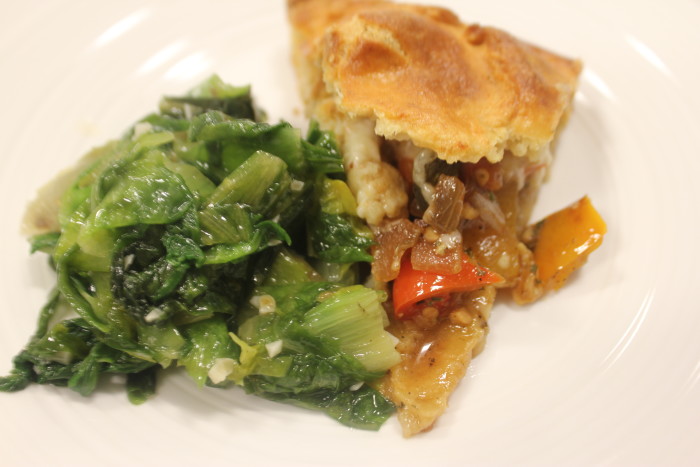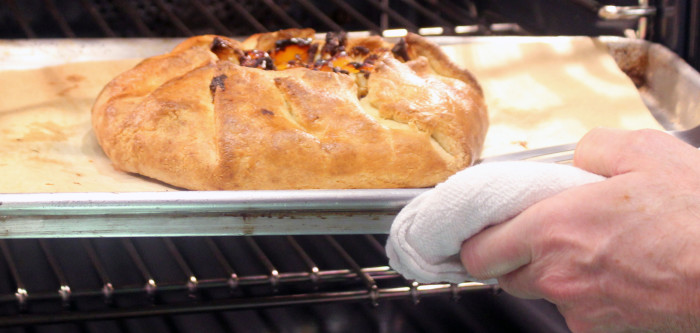This year’s Valentine’s Day feast at Cooking by the Book featured duck breast — yes, that recipe will appear tomorrow.
Now, duck is a little tricky. There’s the fat and how to cook it without generating duck leather. And with its own intense flavor, you have to wonder what to pair duck with. Working with Corinne Trang, Suzen decided to spotlight a dish that could stand on its own as a main course. As a side, this crostata was simply a sumptuous accompaniment to the duck. One forkful of meat, one forkful of eggplant and cheese. What could be more romantic?
Suzie likes teaching students to make crostatas. For one big reason: you cannot fail. Unlike a traditional pie or tart with a pastry topping that just has to be “perfect,” a crostata is the quintessential peasant dish. You roll out the dough, put the goop in the middle, and fold up the sides. It is organic, it is easy, and it will not frustrate you to tears. If you can just fold over a piece of dough, you can make this. Trust me. On Valentine’s Day, we had crostata-novices line up in the kitchen at De Gustibus at Macy’s. Fourteen couples were making dinner and every single person devoured this hearty dish.
Oh, they ate all the duck breast, too. Recipe to follow!
Vegetable Crostata with Honey-Thyme Glaze
Yield: serves 6 to 8
Ingredients:
For the Crust:
- 125 grams all-purpose flour (about 1 cup), more for rolling out dough
- 75 grams fine cornmeal (about 1/2 cup)
- ¼ teaspoon fine sea salt
- 10 tablespoons cold unsalted butter (1 stick plus 2 tablespoons), cut into small cubes
- 35 grams grated extra-sharp Cheddar (about 1/2 cup)
For the Filling:
- 1 ½ pounds different-colored eggplant cut into ¼-inch thick slices (or tomatoes, sliced ¼ inch thick)
- 1 teaspoon kosher sea salt, plus a pinch
- 2 tablespoons cider vinegar
- 1 tablespoons honey
- ½ bunch fresh thyme sprigs, plus 2 tablespoons chopped fresh thyme leaves
- 2 tablespoons olive oil
- 3 garlic cloves, smashed and peeled
- 65 grams extra-sharp Cheddar, grated (about 1 cup) Black pepper, to taste
- 1 large egg
- Flaky sea salt, like Maldon
Preparation:
In a food processor, briefly pulse together flour, cornmeal and salt. Add butter and cheese and pulse until mixture forms chickpea-size pieces (3 to 5 one-second pulses). Add ice water 1 tablespoon at a time, up to 6 tablespoons, pulsing occasionally until mixture is just moist enough to hold together. Form dough into a ball, wrap with plastic and flatten into a disk. Refrigerate at least 2 hours.
Meanwhile, line a rimmed baking sheet with a double layer of paper towels. Spread out tomato slices in a single layer. Sprinkle with 1 teaspoon salt and let sit for at least 1 hour and up to 3 hours.
In a skillet over medium heat, combine vinegar, honey and thyme sprigs and bring to a simmer. Let simmer 2 minutes, then transfer to a bowl. Wipe out skillet, and then add olive oil and garlic. Cook garlic for 2 to 3 minutes, or until garlic is golden and caramelized. Remove garlic and finely chop. Reserve garlic oil.
Line a rimmed baking sheet with parchment paper. Lightly flour a work surface and rolling pin. Gently roll out dough to a 1/4 inch thickness, dusting with flour if dough is sticking. Transfer dough to baking sheet and return to fridge for another 20 minutes.
Heat oven to 425 degrees. Pat tomatoes dry with paper towels. Brush tomatoes with honey mixture (reserve the thyme sprigs). Leaving a 3-inch border, distribute cheese, garlic and half the chopped thyme leaves on center of crust. Add black pepper to taste, then layer tomatoes in an overlapping pattern, maintaining the 3- inch border. Drizzle garlic oil over tomatoes, sprinkle with remaining thyme leaves and lay the reserved whole thyme sprigs on top. Gently fold crust up around tomatoes, making a 2-inch border.
In a small bowl, whisk egg and 1 teaspoon water. Using a pastry brush, brush egg wash over crust and sprinkle top of crostata with flaky salt. Bake for about 35 minutes, until pastry is deeply golden brown. Serve warm or at room temperature.
Source: Corinne Trang at Cooking by the Book with inputs from Wikipedia
Photo Information: Canon T2i, EFS 60mm Macro Lens, F/4.0 for 1/30th second at ISO‑400


